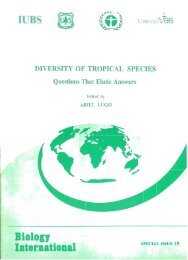SPECIAL ISSUE 34a.pdf - Biology International
SPECIAL ISSUE 34a.pdf - Biology International
SPECIAL ISSUE 34a.pdf - Biology International
You also want an ePaper? Increase the reach of your titles
YUMPU automatically turns print PDFs into web optimized ePapers that Google loves.
<strong>Biology</strong> <strong>International</strong>, Special Issue No. 34 (1997)<br />
(v) Author citation<br />
The one matter of forrn - normally a detail under the Code - that does have<br />
some conceptual implications is that of the citation of author names. The major<br />
difference between botanical and bacteriological usage on the one hand and that<br />
of zoologists on the other, is the "double citation" used in botanical and<br />
bacteriological work. That is, the name of an author transfening a species from<br />
one genus to another, or making a change of rank, e.g. fiom subspecies to<br />
species, is placed outside the parenthetical citation of the original author of the<br />
epithet. The reason for this difference in botanical and bacteriological practice is<br />
not a mere matter of quixotic style, but is quite fundamental. This is obvious in<br />
the case of a change of rank, because precedence (priority) under the botanical<br />
and bacteriological Codes is strictly limited by rank (see below), whereas the<br />
publication of a subspecies under the zoological Code implies the publication at<br />
one and the sarne time of the same epithet (name) at species rank - and vice-<br />
versa.<br />
The same conceptual basis exists in the case of a transfer to a new genus<br />
because precedence of the combination (as opposed to the epithet) under the<br />
botanical and bacteriological Codes dates only from the time of the transfer,<br />
whereas under the zoological Code, it dates from the original publication of the<br />
epithet "species narne", and takes precedence over an independent usage of the<br />
name in the genus to which transfer is being made, the so-called secondary<br />
homonym situation in zoological nomenclature (see below). For exarnple, the<br />
full author citation with the date of transfer to Rhododendron, e.g. in the form<br />
Rhododendron japonicum (A. Gray) Suringer (1 908), based on Azalea japonica<br />
A. Gray (1 859), is essential to explain why this name has precedence, under the<br />
ICBN, over Rhododendron japonicum (Blume) Schneider (1909), based on<br />
Hymenanthes japonica Blume ( 1 826). Under the ICZN, the priorities would be<br />
reversed, the only critical dates, and hence the only critical citation being that of<br />
the original author. [See (iii) Secondary Homonymy under (e) Concepts,<br />
below.]<br />
The double citation in bacteriological and botanical nomenclature is thus a<br />
natural concomitant of not recognizing secondary homonymy and rejecting coordinate<br />
status. As the Draft BioCode also does not recognize secondary homonymy,<br />
1 believe that it errs in not requiring double citation on transfer between<br />
genera, although, as it does provide for CO-ordinate status, it is correct in abandoning<br />
the bacteriological and botanical tradition of double citation on changes<br />
of rank within the species, genus and family groups.<br />
(c) Coverage<br />
The Codes Vary in terms of the ranks covered by their provisions. Essentially<br />
there are two elements involved: the ranks to which precedence applies, and the<br />
ranks which are governed only by other provisions of a particular Code. In the<br />
case of the ICZN, these are identical: the ICZN regulates only "the names of taxa<br />
in the family, genus and species groups" (Art. 1 (a)), and in al1 these the rule of<br />
precedence applies (Art. 23). The ICBN, while restricting precedence to the rank




